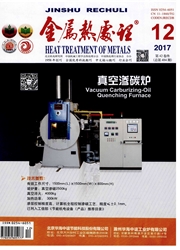

 中文摘要:
中文摘要:
采用静态拉伸、线性回归处理等方法研究了不同热处理工艺对冷卷用60Si2Cr VAT弹簧钢盘条的力学性能及拉伸应变硬化行为的影响。结果表明,试验弹簧钢的强度和硬度均随回火温度的升高而下降。在低于470℃回火时,应变硬化指数n符合Hollomon方程,且随回火温度的升高n值下降;在高于470℃回火时,材料的应变硬化指数出现双n值特征,其中在低应变区n值随回火温度的升高而下降,在高应变区n值则随回火温度的升高而升高。试验钢的应变硬化速率随应变改变而变化的规律与n值的变化规律相似。综合考虑强度、硬度、塑性、应变硬化指数和应变硬化速率等因素,确定910℃淬火后530℃回火更有利于60Si2Cr VAT钢盘条的冷卷成形。
 英文摘要:
英文摘要:
Effect of different heat treatment processes on mechanical properties and tensile strain hardening behavior for cold coiling spring steel 60Si2 Cr VAT was studied by means of static tension and linear regression processing. The results show that the strength and the hardness of the tested spring steel decrease with the increasing of tempering temperature. When the tempering temperature is lower than 470 ℃,the strain hardening index n of the material accords with Hollomon equation,and the value of n decreases with the increasing of tempering temperature. When the tempering temperature is higher than 470 ℃,the strain hardening index presents double value of n characteristics. In addition,the value of the strain hardening index decreases with the increasing of the tempering temperature in low strain zone while it increases with the increasing of tempering temperature in high strain zone. The variation laws of the strain hardening rate varying with the change of strain are similar to those of the value of n. Considering the factors such as strength,hardness,plasticity,strain hardening index and strain hardening rate comprehensively,the more appropriate heat treatment process for the cold coiling of 60Si2 Cr VAT spring steel is quenching at 910 ℃ and tempering at 530 ℃.
 同期刊论文项目
同期刊论文项目
 同项目期刊论文
同项目期刊论文
 期刊信息
期刊信息
